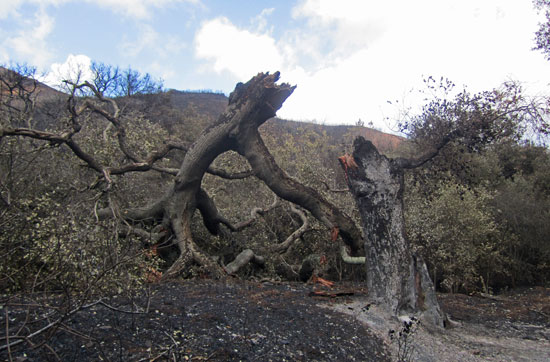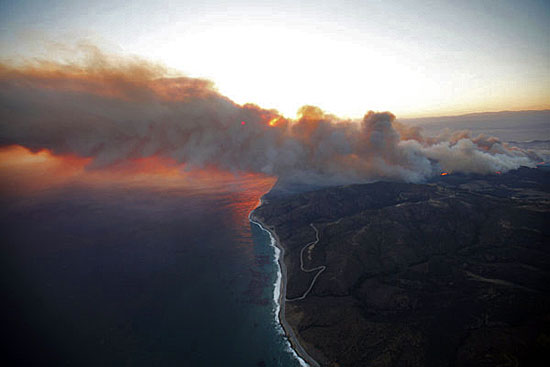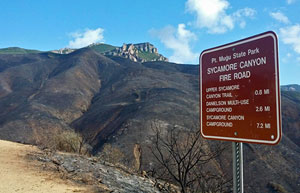Burning questions
May 9, 2013
When wind-driven flames tore through one of the Santa Monica Mountains’ most scenic canyons last week, hearts sank with visions of another city escape transformed into a smoldering moonscape.
Sycamore Canyon draws thousands of visitors every month with its gorgeous vistas, canopied trees and a network of trails suitable for everyone from strolling couples to hardcore hikers. So the big question was this: exactly how destructive was the fire that ignited near Newbury Park in the inland valley and didn’t stop until it reached the sea at Point Mugu State Park, about 30 miles north of Santa Monica?
Over the past couple of days, some answers—along with new questions—have emerged, as national and state parks experts have hit the charred ground to begin investigating the fallout from the only spring wildfire in anyone’s memory.
What they’ve found might be good news for people eager for a return to the trails but troublesome for the area’s wildlife, especially its birds, now in their prime nesting season. “Normally, with fall fires, that’s not going on,” said fire ecologist Marti Witter of the National Park Service. “There was probably a significant hit to bird populations.”
The rare early timing of the so-called Springs fire also has raised questions about the regenerative resilience of burned trees, which were in their spring growth period and already were challenged by drought conditions. Deciduous trees, such as the sycamores, had yet to begin moving nutrients from their leaves to their trunks, as they do during the late summer and fall months. Those leaves are now scorched or incinerated. At a minimum, experts predict that damaged trees could remain leafless and unsightly for months longer than if the blaze had erupted later in the year during the normal fire season, when subsequent wetter months help force new growth.
“People are going to be looking at a black landscape much longer than they normally would,” said Witter, of the park service’s Santa Monica Mountains National Recreation Area.
For now, the public won’t be seeing anything; officials have ordered a two-week closure of the Sycamore Canyon Trail area until an assessment of the potential dangers can be determined. A key player in that process is National Park Service plant ecologist John Tiszler, who, like Witter, also works in the Santa Monica Mountains National Recreation Area. Earlier this week, he toured the popular lower canyon on behalf of Ventura County fire officials.
“Clearly, the vast majority of it burned,” Tiszler said. “I know people are very worried about this but I don’t think there’s any reason to think that a catastrophe has occurred.”
Tiszler said “the fickleness of the winds” had left some spots unscathed as the flames quickly shifted through the broad lower canyon beyond the undamaged Point Mugu campground. Those scattered green zones, he said, could provide refuge for displaced, nesting birds and such ground wildlife as lizards, which park service staffers are attempting to rescue. (Click here for a satellite image of the “burn scar.”)
Tiszler said that, in the lower canyon, he flagged only 15 sycamores and oaks that had the potential to fall along the fire-road trail. Only three or four of them, he said, should be taken down. But in the canyon’s upper, narrower passages, he said, the toll appears worse because of more intense flames and heat.
The staying power of all those affected trees could be tested in the days ahead, Tiszler said, when high winds are expected to whip through the area again. He also said a looser standard will be applied to damaged trees along hiking trails that don’t have gathering areas, where the public might linger and be at greater risk. “If there’s no person, car or picnic table,” he said, “then the potential of being a public hazard is much reduced.”
Tiszler also noted that trees in Sycamore Canyon had withstood a number of blazes over the decades, including the more devastating Green Meadow fire in 1993. “Trees are like alien beings from another planet,” he said. “They are so different from us, the way they heal themselves, what they tolerate.” He said trees can stand strong even with deep hollows burned into their core because their weight is borne by their outer rings.
Like many veteran hikers and naturalists, Ron Webster of the Sierra Club does not view flames as an enemy of Sycamore Canyon’s trails, a good number of which he helped cut years ago. “You know, it’s just fire. The place greens up and then we’re off again,” said Webster, who, at 78, still leads trail crews in the Santa Monica Mountains.
“Be sure to schedule hikes there in the spring. You’ll see wildflower displays like you won’t believe,” Webster said, noting that seeds have long been lying dormant under the deep chaparral that has been burned away.
Witter of the park service said she, too, has learned to put the area’s fires in perspective. A longtime Topanga resident, she remembers the destruction of property—and the uprooting of lives—from the wildfires two decades ago that cut a fiery path from the mountains around her neighborhood to the ocean’s edge in Malibu.
“Seeing all those burned homes, that was emotionally devastating,” Witter recalled. “This fire has changed the landscape, but it should come back.”

Fire hollowed out the core of this broken oak so its outer rings could no longer support its weight.
Posted 5/10/13



















 405 bridge work causes a stink
405 bridge work causes a stink
